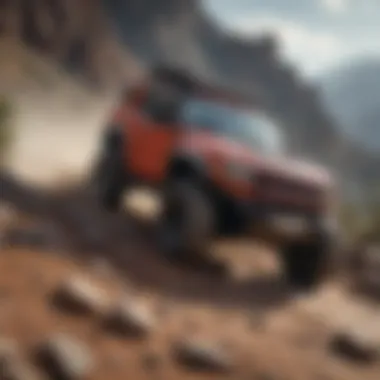Discovering the Best Four Wheeler Riding Spots Nearby


Intro
Four wheeler riding offers a unique blend of adventure and exploration. Each location reveals new paths and experiences. This guide aims to discuss several riding places nearby, focusing on their accessibility and diverse terrains. Understanding these sites will help both casual riders and dedicated enthusiasts engage effectively with their environment.
Safety plays a crucial role when venturing off-road. Identifying proper precautions is essential for an enjoyable riding experience. Additionally, preparing your vehicle for varying challenges ensures a smoother journey. This comprehensive guide aims to inform readers about local riding spots, highlighting practical details that cater to various skill levels.
Coverage Options
Selecting the right coverage for your vehicle is vital. It protects against potential damages and liabilities that may arise during your riding adventures. Understanding different options available can aid in this decision.
Types of Coverage Available
Different types of coverage can help you navigate off-road riding better. Typical options include:
- Comprehensive Coverage: Offers protection against various risks beyond collisions. It may cover theft, vandalism, and natural disasters.
- Collision Coverage: Designed primarily for accidents involving another vehicle or an object. This type helps cover repair costs regardless of who is at fault.
- Liability Coverage: This protects against damages you may cause to others. It ensures you are covered if someone else suffers loss or injury due to your actions while riding.
Liability Coverage Explained
Liability coverage is significant in off-road riding. It safeguards not only your interests but also the interests of other riders and pedestrians. Understanding the limits of this coverage ensures that you are adequately protected. If incidents occur, this coverage assists in managing the financial aftermath involving medical expenses or property damages.
Key Considerations
Riders often overlook certain factors when choosing insurance, which can lead to insufficient preparation. Here are key considerations to keep in mind:
Factors to Assess When Choosing Insurance
Evaluate the following factors to curate the best insurance package:
- Terrain Type: Certain policies may have restrictions based on where you ride.
- Frequency of Use: Regular riders may require higher coverage levels compared to occasional users.
- Vehicle Value: Knowing the worth of your vehicle helps determine necessary coverage.
- Personal Risk Tolerance: Assess how much risk you are comfortable with.
Understanding Policy Limits
Familiarize yourself with the policy limits of your coverage. These limits indicate the maximum amount your insurer will pay. It is crucial to align these limits with potential risks identified in your riding environment. A misunderstanding regarding the policy may lead to unanticipated gaps in coverage.
"Being informed about your insurance options is just as critical as preparing your vehicle for the terrain ahead."
In summary, understanding coverage options and key considerations when riding your four wheeler can significantly enhance your experience. The right coverage not only protects you financially but also allows you to focus on the thrill of the ride.
Understanding Four Wheeler Riding
Four wheeler riding encompasses a diverse range of experiences suitable for various enthusiasts. This section serves as an introduction to the key elements that define this exciting activity. Four wheeler riding is not merely about driving; it is about exploring nature, enjoying the outdoors, and experiencing a sense of adventure. Recognizing the critical aspects helps riders make informed decisions about their preferred locations and vehicles.
What Constitutes Four Wheeler Riding
Four wheeler riding involves utilizing vehicles designed specifically for navigating different terrains. These vehicles provide drivers the ability to traverse varied landscapes, including rough trails, sand dunes, and muddy paths. The core components of this activity include vehicle performance, rider skill, and environmental considerations. Understanding these elements ensures a safer and more enjoyable experience for all participants.
Different Types of Four Wheelers
In exploring four wheeler riding, it is imperative to consider the various types of vehicles available, each offering unique features and capabilities. The choice of vehicle often influences the overall riding experience.
ATVs
All-terrain vehicles, commonly known as ATVs, are designed for handling rugged terrains with ease. One specific aspect of ATVs is their compact size, allowing them to maneuver through tight spaces and challenging paths. This makes them a popular choice for off-road enthusiasts who enjoy exploring remote areas. The key characteristic of ATVs is their powerful acceleration and agility, which allows riders to navigate difficult obstacles effectively. However, riding an ATV requires proper skills and knowledge, particularly when dealing with steep inclines or declines.
SUVs
Sport Utility Vehicles, or SUVs, offer a blend of comfort and off-road capability. A significant aspect of SUVs is their spacious interiors, making them suitable for family outings or group rides. Many modern SUVs are equipped with advanced technology, such as all-wheel drive systems, enhancing their ability to handle rough terrains. This makes them a versatile choice for riders who may not be experienced off-roaders. One advantage of an SUV is its ability to carry more passengers and gear, although it may lack the agility and speed of an ATV when faced with extreme off-road conditions.
Pick-up Trucks
Pick-up trucks are an excellent option for those seeking utility in addition to recreational riding. A defining feature of pick-up trucks is their open bed, which provides ample space for transporting equipment or other vehicles. This makes them beneficial for group outings or those needing to carry extra gear. Furthermore, many pick-up trucks are built with robust engines and systems capable of handling demanding off-road terrain. While they offer significant advantages in terms of utility, their larger size can make navigating narrow trails more challenging compared to ATVs.
Understanding the different types of four wheelers is essential for selecting the vehicle that best suits your riding style and the terrains you wish to explore.


In summary, understanding four wheeler riding requires a focus on various factors, including vehicle types and their specific advantages. Each option has its unique characteristics that contribute to the overall experience, making it vital for riders to choose wisely.
Factors to Consider When Choosing Riding Locations
Choosing the right location for four wheeler riding is essential for a satisfying experience. Various factors play a significant role in ensuring that a riding location meets your needs and expectations. By considering specific elements such as terrain conditions, legalities, safety requirements, and amenities, you can make informed decisions that enhance your riding adventures. Let's take a closer look at some important factors to consider when selecting a riding destination.
Terrain Conditions
Off-Road Trails
Off-road trails are a fundamental aspect of four wheeler riding. They usually offer varied landscapes, which challenge riders and provide enjoyable experiences. These trails are well-marked, making navigation easier. Many riders enjoy the excitement of maneuvering through twists and turns, which can be very engaging. However, not all off-road trails are the same. Some can be steep or covered in rocks, posing potential risks for inexperienced riders.
Sand Dunes
Riding on sand dunes presents a unique experience for enthusiasts. The softness of sand allows for a different riding style, often enabling smooth transitions between rises and valleys. It's essential to know that sand dunes can be challenging due to their shifting nature. Skillful handling is required to maintain control. Many riders find the challenge rewarding since it enhances their skills while enjoying beautiful vistas.
Mud Pits
Mud pits are a polarizing feature in four wheeler riding. They attract adventurous spirits looking for challenges. Driving through mud can be exhilarating, offering a sense of triumph when successfully navigating through. However, mucky environments come with high risks. Getting stuck is a common issue, which not only affects the ride but also requires recovery efforts. Therefore, it's important to weigh the fun against the potential hassle.
Legal and Safety Considerations
Local Regulations
Understanding local regulations is vital before you decide where to ride. Different areas have their specific rules regarding off-road riding. Ignoring these regulations can result in fines or other consequences. Therefore, familiarizing yourself with the laws in your chosen location will help provide a safe and legal experience.
Safety Gear Requirements
Every riding location may have various safety gear requirements. Wearing appropriate gear like helmets, gloves, and protective clothing is crucial. Local regulations might enforce these protocols, ensuring riders maintain safety standards. A good investment in safety gear can prevent injuries and enhance your overall riding experience.
Proximity to Amenities
Fuel Availability
Fuel availability is a practical concern for any four wheeler ride. Before embarking on your adventure, make sure your destination provides nearby fueling options. Being stranded due to lack of fuel can turn an exciting day into a frustrating one. Researching in advance can save time and hassle during the trip.
Emergency Services
Proximity to emergency services is another essential factor. Off-road riding is unpredictable, and accidents can happen at any time. Knowing that help is nearby can provide a sense of security. Some areas are remote, making it difficult to reach help quickly when needed. Assessing this aspect can significantly influence your choice of riding locations.
Popular Four Wheeler Riding Places
The topic of popular four wheeler riding places is pivotal in this guide. These locations provide not only an exciting adventure for enthusiasts but also a structured environment that enhances safety and enjoyment. By highlighting various riding spots, this section aims to equip riders with the knowledge to choose places that are well-suited for their skill level, vehicle type, and preferences.
Understanding the benefits of these locations is essential. This includes access to designated trails that are maintained and monitored. Such areas also often have facilities that make the riding experience more pleasant, such as parking, restrooms and nearby fuel availability. In addition, these spots can provide a sense of community with other riders, allowing for shared experiences and tips for navigating the terrain.
State Parks and Recreation Areas
State parks are one of the best places for four wheeler riding. They generally offer a vast range of trails and varied landscapes, which makes them appealing to riders of different experiences. Most of these parks have specific areas designated for off-road vehicles. This helps ensure that riders are away from pedestrian zones and can enjoy their rides safely.
In additon to the trails, state parks often feature picturesque scenery. Riders can benefit from natural landscapes, which adds to the enjoyment of their experience. However, users should be aware of any permits required for riding in state parks. Ensuring compliance is critical to avoid fines or other penalties.
Local Off-Road Trails
Local off-road trails can offer a level of excitement and adventure that attracts many riders. They can vary significantly in difficulty and terrain type. Riders should consider their skill level and the type of four wheeler they own, as some trails can be very challenging.
Local trails may be less regulated than state parks. This means riders must be vigilant about safety practices and legal guidelines. Connecting with local riding clubs or communities can provide valuable information about the best trails in the area and how to access them. Community-driven knowledge is often the most trustworthy when seeking hidden gems for off-road experiences.
Organized Riding Events
Organized riding events can greatly enrich the four wheeling experience. These activities are often planned in advance and attract riders from various locations. They can range from casual meet-ups to competitive events that test skills and camaraderie among participants.
Attending organized events allows riders to experience well-planned routes and sometimes even guided tours. It also provides an opportunity to network with other riders, exchange tips, and learn from more experienced enthusiasts. However, participation may require prior registration or entry fees. Riders should confirm any requirements ahead of time to make the most of their experience.


By exploring these popular four wheeler riding places, riders can enhance their adventures while ensuring safety and enjoyment, emphasizing the value of planning.
In summary, identifying suitable four wheeler riding locations can significantly impact the overall experience. Whether it be state parks, local trails, or organized events, each setting offers unique benefits and challenges. Understanding these aspects enhances both the enjoyment and safety of four wheeler riding.
Evaluating Local Riding Options
When considering a four wheeler adventure, evaluating local riding options is essential for creating a fulfilling experience. This evaluation encompasses various aspects, such as accessibility, terrain suitability, and safety protocols. A thorough assessment helps determine not only where to ride but also what to expect during the journey. Riders are encouraged to examine local resources, as exploring nearby spots can uncover hidden gems that might otherwise be overlooked.
Researching Locations Online
In the digital age, researching riding locations has never been easier. A simple online search can yield a wealth of information about nearby parks, trails, and events dedicated to four wheeler riding. Utilizing various websites such as en.wikipedia.org or local forums can provide valuable insights into the conditions and characteristics of each potential riding area. Here are some key elements to consider while researching:
- Map Resources: Online maps can show the exact routes and surrounding areas, helping riders gauge accessibility.
- Reviews and Ratings: Websites like Reddit and Facebook allow users to share experiences. Such reviews can highlight potential issues like crowded areas or trail quality.
- Social Media: Follow local clubs and groups to discover recent updates on conditions and upcoming riding events.
- Video Content: Platforms such as YouTube can give a visual perspective on trails, showing clear representations of terrain and challenges.
Being detail-oriented when researching ensures that riders are prepared for their outing.
Community Recommendations
Community recommendations provide a personal touch to evaluating four wheeler riding options. Fellow riders often share firsthand experiences that can inform decisions significantly. To tap into this resource, consider the following:
- Local Riding Clubs: Connecting with clubs can yield insider knowledge about the best locations and lesser-known trails.
- Meetup Groups: These groups often organize rides, making them a great way to experience safe and enjoyable riding with others.
- Social Media Groups: Online communities can be excellent sources for advice, trail conditions, and safety tips from more experienced members.
Engaging with community members not only enhances riding options but also builds a network of fellow enthusiasts.
Overall, evaluating local riding options through thorough research and community engagement equips riders with the knowledge needed for an enjoyable exploration. By understanding what is available nearby, riders can confidently choose destinations that meet their skill levels and interests.
Preparing for a Ride
Preparing for a ride is a fundamental aspect of four wheeler riding that should not be overlooked. This phase allows riders to ensure that both their vehicle and their equipment are in optimal condition, significantly reducing the risks associated with off-road activities. Proper preparation can enhance the overall experience, leading to safer and more enjoyable rides.
Essential Gear and Equipment
When heading out for a ride, selecting the right gear and equipment is crucial. Essential items include helmets, protective clothing, gloves, and suitable footwear. Helmets can prevent serious injuries in case of accidents. Protective clothing, such as padded jackets and pants, helps to minimize abrasions and impacts.
Here are some key points to consider for gear selection:
- Visibility: Choose bright colors for jackets and vests to ensure visibility.
- Comfort: Make sure the gear fits well and allows for easy movement.
- Durability: Select equipment that can withstand harsh conditions.
Equipping yourself appropriately not only enhances safety but also boosts confidence while navigating challenging terrains.
Vehicle Maintenance Checks
Proper vehicle maintenance checks are vital before undertaking any off-road adventure. Two primary areas to focus on are tires and suspension, alongside fluid levels to ensure that everything is functioning as it should.
Tires and Suspension
Tires play a critical role in any four wheeler's performance and safety. The right tires provide adequate traction and stability, especially on uneven or muddy surfaces.
Key characteristics of tires include:
- Tread Pattern: Specific patterns are designed for off-road traction.
- Air Pressure: Maintaining proper tire pressure enhances control and reduces wear.
The suspension system also ensures that the vehicle can handle rough terrains without losing stability. A well-adjusted suspension contributes to comfort and safety, allowing for smoother rides.
Advantages:
- Improved traction and vehicle control.
- Better handling of bumps and dips.
These features are essential for anyone looking to enjoy a smooth and trouble-free riding experience.
Fluid Levels
Checking fluid levels is another essential maintenance step. This includes engine oil, coolant, and brake fluid. Low levels can lead to serious mechanical issues during a ride.


Key points about fluid levels include:
- Engine Oil: Lubricates internal components, ensuring smooth operation.
- Coolant: Helps prevent overheating, especially in tough conditions.
- Brake Fluid: Essential for safe stopping capabilities.
Maintaining appropriate fluid levels goes a long way in enhancing reliability. Neglecting these checks can lead to expensive repairs or unsafe situations on the trails.
Planning Your Route
Before heading out, it is crucial to plan your route. Consider the type of terrain, potential hazards, and the total distance of the trip. Utilize maps or GPS applications to mark interesting spots and as a guide.
"Planning reduces uncertainties, allowing riders to enjoy the adventure without worrying about unexpected obstacles."
Make sure to take note of rest stops and fuel sources along your route. Inform others about your plan, so someone knows your intended path and timeline.
In summary, preparing for a ride encompasses practical steps that improve safety and enjoyment. From gear selection to vehicle maintenance and route planning, each element is a building block for a successful four wheeler experience.
Post-Ride Considerations
After an exhilarating four wheeler ride, reflection and maintenance are crucial elements that often get overlooked. Understanding the importance of post-ride considerations can enhance future experiences and ensure your vehicle remains in optimal condition. This section focuses on evaluating your experience, maintaining your vehicle, and sharing insights with fellow riders.
Evaluating Your Experience
Taking the time to evaluate your ride can provide valuable insights into what worked well and what could improve. Reflecting on various aspects of the outing can help in planning better rides in the future. Consider the following points while evaluating:
- Terrain Suitability: Did the terrain meet your expectations? Were there any areas that posed challenges? Understanding the comfort level with different terrains informs future choices.
- Riding Companions: Who you ride with can greatly affect the experience. Was the group dynamic positive? It may be beneficial to discuss individual preferences.
- Time Management: Did the duration of the ride feel appropriate? Planning the time better can lead to more enjoyable experiences.
- Overall Enjoyment: Reflect on the ride's enjoyment level. Were there moments that stood out? Documenting these can enrich future outings.
Vehicle Cleaning and Maintenance
Cleaning and maintenance should not be viewed as a chore, but rather as essential practices for prolonging the life of your vehicle. The aftermath of a ride typically leads to dirt and debris accumulation which can cause long-term damage if not promptly addressed. Focus on the following tasks:
- Washing: Rinse off mud, dirt, and sand using the appropriate cleaning supplies. Pay special attention to parts that may trap debris, such as the undercarriage and wheel wells.
- Inspection: Post-cleaning, conduct a thorough inspection of the vehicle. Look for scratches, dents, or any signs of wear and tear that may need repair.
- Fluid Checks: Ensure all fluid levels are adequate, including oil, brake fluid, and coolant. This practice helps in maintaining the functionality of the vehicle.
- Storage: If you plan to store the vehicle for an extended period, consider protective covers to shield it from the elements.
Sharing Your Ride Experience
Sharing your experiences can enrich the community of four wheeler enthusiasts. Documenting your ride through blogs, social media, or forums can provide insights to others looking to explore similar terrains. Consider these strategies:
- Online Communities: Platforms like Reddit and forums dedicated to four wheeling are excellent for sharing experiences. Engaging with others can foster connections and spark new ideas.
- Social Media: Utilize social media platforms to showcase your ride. Photos, videos, and story highlights can capture moments and generate discussions.
- Feedback: Encourage feedback from your readers or followers. This interaction can lead to improved riding strategies for everyone involved.
Incorporating these post-ride considerations can transform your experience. Not only do they allow you to reflect and care for your vehicle, but they also create opportunities for community interaction and shared learning. As always, being proactive in these areas contributes to safer, more enjoyable four wheeler adventures.
Safety Tips for Four Wheeler Riders
Safety is a cornerstone in the adventure of four wheeler riding. Pitfalls abound for the unprepared, making safety guidelines indispensable. Whether you ride for leisure or as a sport, understanding safety tips can significantly influence the outcome of your expedition.
This section outlines essential considerations. First, riding in groups enhances safety through collective awareness. Additionally, mastering navigation over difficult terrains can prevent accidents and vehicle damage. Together, these tips contribute to a more enjoyable, accident-free experience.
Always prioritize safety to ensure a rewarding riding experience.
Riding In Groups
Riding in groups has clear advantages. A group can watch for hazards together, share knowledge about trails, and assist one another in case of emergencies. Consider establishing a leader and a sweeper. The leader sets the pace and navigates, while the sweeper ensures everyone stays together.
Key Benefits of Riding in Groups:
- Shared Knowledge: More experienced riders can guide less knowledgeable participants through tricky sections.
- Emergency Response: In emergencies, having fellow riders means immediate assistance is available.
- Motivation and Fun: A group setting promotes camaraderie, making rides more enjoyable.
- Route Planning: Discussing and planning routes as a group can lead to discovering new locations.
It is crucial to establish communication tools, such as handheld radios or signal flags, to relay messages. Ensure everyone understands the route and rules before embarking.
Navigating Difficult Terrain
Navigating difficult terrain requires skill and preparation. This includes steep inclines, rocky paths, or muddy sections. Understanding how to handle these challenges is vital for rider safety and vehicle integrity.
Tips for Successfully Managing Difficult Terrain:
- Maintain Control: Slow down before difficult sections to better manage your vehicle's handling.
- Know Your Vehicle: Each four-wheeler has unique specifications. Understanding its limitations and strengths is essential.
- Use the Right Techniques: Techniques like throttle control, weight distribution, and judicious use of brakes are essential.
- Be Cautious of Weather Conditions: Wet or muddy conditions greatly affect traction. Adapt driving styles accordingly.
Practicing navigational skills in safe environments helps develop confidence. Try tackling less difficult terrains before progressing to more challenging ones. This ensures both rider and vehicle are ready for the demands ahead.
By internalizing these safety tips, four wheeler riders can enhance their experiences, minimize risks, and improve skills. Safety should always be a priority in every ride.



